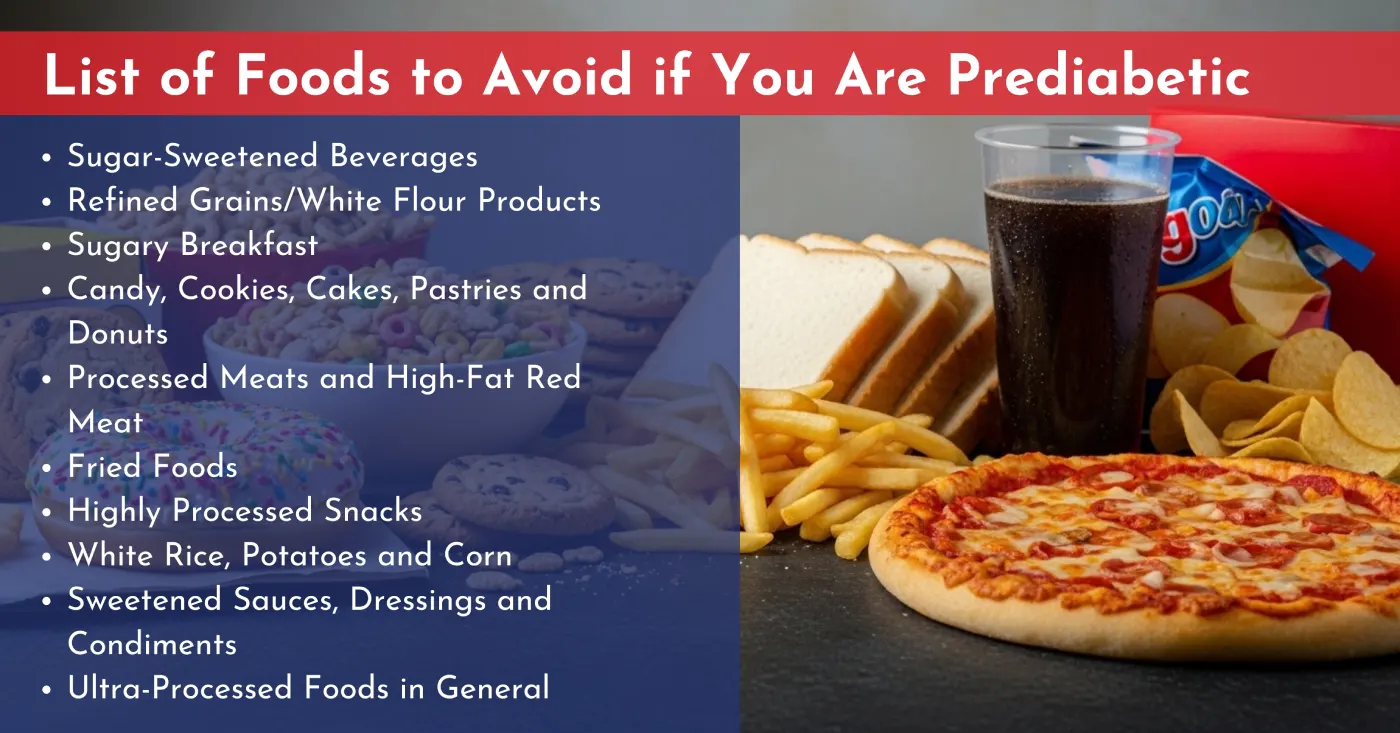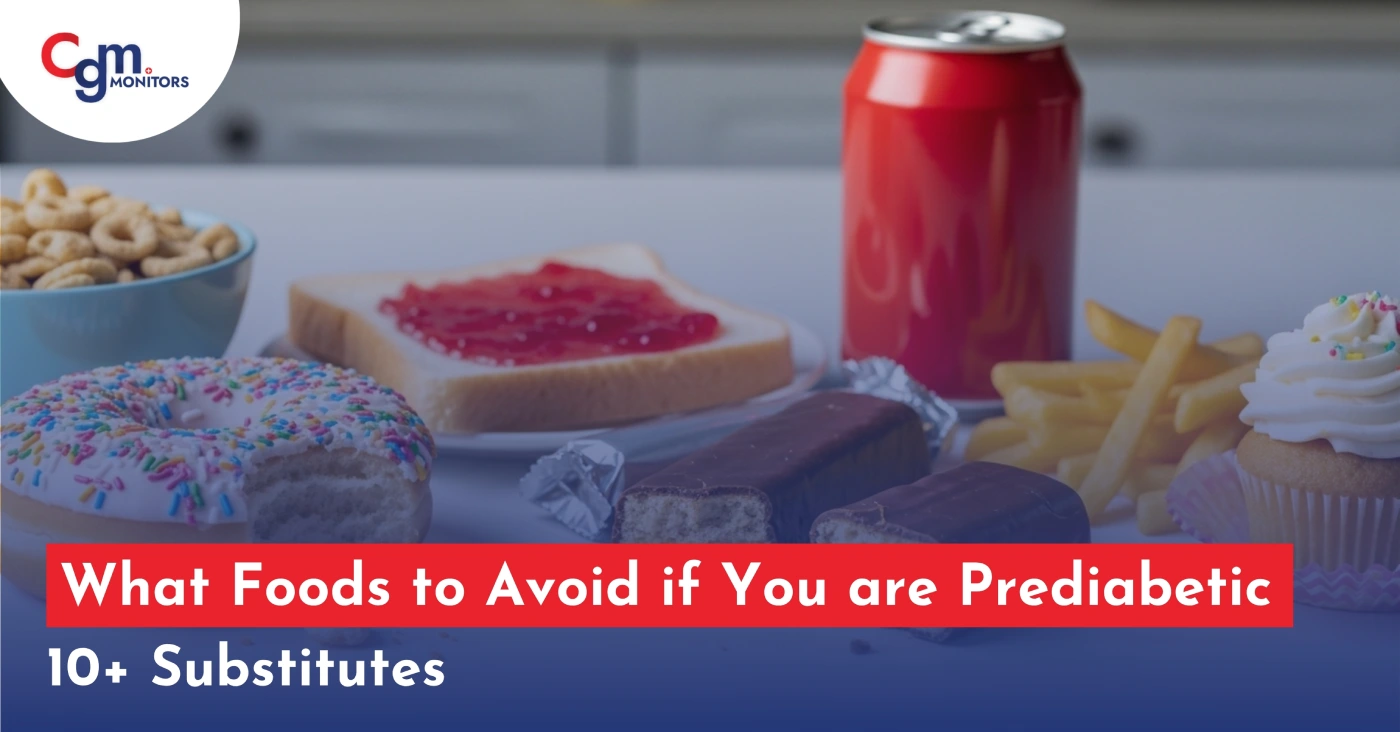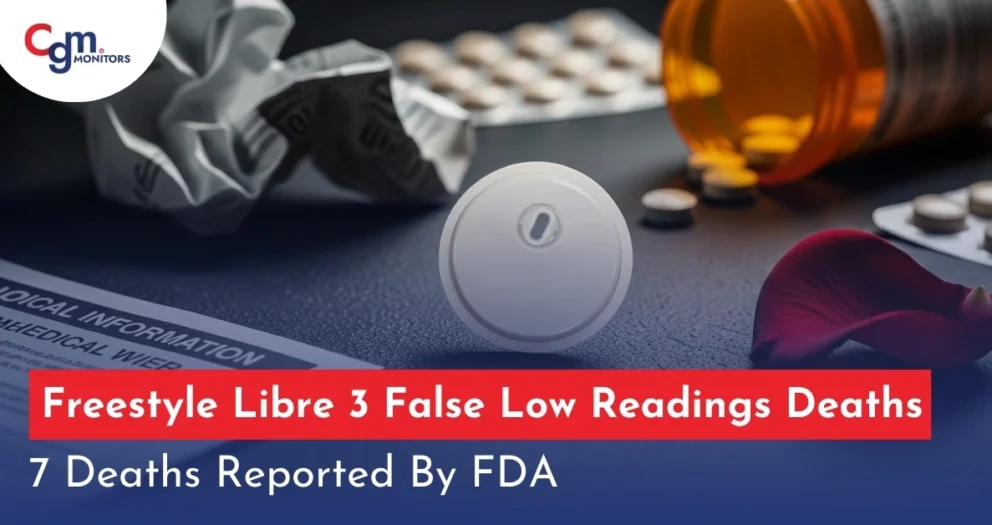Table of content
Carbohydrates are the main source of energy, especially for high-intensity exercises, while for low-intensity ones, energy from good fats can do the job. There are 3 types of carbohydrates, i.e., carbs from starchy foods (like grains, starchy vegetables, or sugary foods), carbs from non-starchy foods (like cauliflower, berries, or citrus fruits), and carbs from fiber-rich foods (like oatmeal, walnuts, broccoli, or seeds). If you are diabetic or prediabetic, you need to cut down on starchy foods, limit non-starchy foods, and consume fiber-rich foods; however, maintain portion size and refrain from consuming bigger meals. Let’s dive deep into ‘What Foods to Avoid if You are Prediabetic?’
List of Foods to Avoid if You Are Prediabetic
The following is a list of foods diabetics and prediabetics should limit or avoid when managing prediabetes:
1. Sugar-Sweetened Beverages
Sodas, sweet tea, and fruit “drinks” contain added sugar, which delivers sugar fast and causes blood glucose spikes.
Substitute: Plain water, sparkling water, unsweetened tea, or coffee.
2. Refined Grains/White Flour Products
White flour or refined grain products, e.g., white bread, bagels, white pasta, regular tortillas, undergo a milling process where fiber is removed.
Substitute: Whole grain (intact) breads, whole-wheat pasta, sprouted grain wraps.
Eat while maintaining portion control and according to your blood sugar conditions. Even better if you make informed eating decisions based on your blood sugar.
Continuous glucose monitors, commonly known as CGMs, may help. Claim yours today from CGM Monitors.
3. Sugary Breakfast
Breakfasts like cereals, granola bars, or pancakes with sugary syrups are loaded with added sugar.
Substitute: Steel-cut oats, plain oatmeal with nuts and berries, homemade muesli.
4. Candy, Cookies, Cakes, Pastries and Donuts
Remember that concentrated sugar and refined carbs lead to blood sugar spikes.
Substitute: Small portions of dark chocolate (70%+), or fruit & nut mixes (unsweetened) would not just save you from sugar spikes but provide other health benefits as well.
5. Processed Meats and High-Fat Red Meat
Bacon, hot dogs, salami, deli meats, etc., often come with saturated fat and additives.
Substitute: Lean meats, such as skinless chicken, tofu, and legumes. Fish would be even better.
6. Fried Foods
Frying adds unhealthy fats (low-density lipoprotein), which you do not want, as it can build plaque in arteries, ultimately leading to cardiac issues.
Substitute: Baked, steamed, or air-fried versions of veggies (try limiting starchy vegetables) or proteins.
7. Highly Processed Snacks
Chips, crackers, cookies, and packaged snack cakes are often refined carbs.
Substitute: Nuts, seeds, roasted chickpeas, or even veggie sticks with hummus dip.
8. White Rice, Potatoes and Corn
These starchy vegetables (and grains), containing carbs, digest quickly and can spike blood sugar.
Substitute: Quinoa, barley, bulgur, or ‘’cauliflower rice” with sweet potato in moderation.
Check the cauliflower rice recipe at Loveandlemons.
9. Sweetened Sauces, Dressings and Condiments
Condiments such as ketchup, BBQ sauce, and bottled dressings often contain hidden sugar.
Substitute: Olive oil with vinegar, mustard, homemade dressings with herbs and lemon juice.
10. Ultra-Processed Foods in General
Foods like the pre-packaged meals or factory-made bread belong to ultra-processed items. They tend to be high in added sugar, refined flour, unhealthy fats, salt, and additives.
Substitute: Whole foods, minimally processed ingredients, fresh produce, and whole proteins.
While not always, wrappers are a general sign of ultra-processed foods.

Choose Food with Low GI and Rich Fiber Content
- The consensus nutrition guidelines emphasize choosing carbohydrate foods rich in fiber, vitamins, minerals and low in added sugar, fat, and sodium.
- A low-glycemic index eating approach can help you avoid sharp blood sugar spikes.
- Instead of focusing purely on “low GI,” prioritize nutrient quality: whole, unprocessed, fiber-rich foods.
- Studies show that higher daily fiber intake (from foods) can modestly lower A1C (long-term blood sugar) by ~0.2–0.3 %.
Remember: Managing diet + physical activity + sleep together may help reverse or manage prediabetes.
Conclusion:
Except for carbohydrates from fiber, which are beneficial, you want to avoid foods that are high in carbs, such as refined grains, potatoes, sugar, white bread, or starchy vegetables. There are substitutes for all such cravings, and they are given above.
Frequently Asked Questions
What is the best diet for prediabetes management?
A balanced diet of vegetables, healthy proteins, whole grains (in moderation), healthy fats, low GI carbs — often described via Mediterranean or DASH dietary patterns.
What should be the diet for prediabetes and high cholesterol?
Focus on good fats (olive oil, nuts, walnuts, avocados), fish (omega-3), lean protein, and soluble fiber (oats, beans). Avoid saturated fats and trans fats.
Diet to reverse prediabetes / Reverse prediabetes diet?
Remember the ‘No GPS rule’: no grains (refined), potatoes, and sugar. While maintaining portion size, you may consume a diet that is rich in fiber, whole foods, low GI carbs, moderate protein, and healthy fats.
Disclaimer: Meant for informational purposes only, this blog does not constitute medical, legal, or professional advice. And while we strive for accuracy, errors or omissions may occur.
This blog may contain AI-generated images for illustrative purposes only. Device images belong to their respective manufacturers and are used here for reference. Actual products may vary.







Write a comment
Your email address will not be published. All fields are required